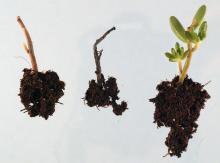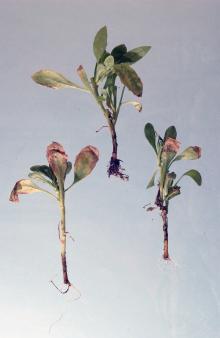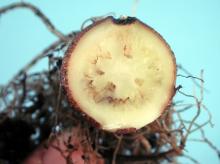See:
Greenhouse Plants, Ornamental - Pythium Seed Rot, Damping-off, and Root Rot
Greenhouse Plants, Ornamental - Rhizoctonia Damping-off, Root and Stem Rot
Cause Several Fusarium spp. are possible with Fusarium oxysporum the most prevalent, however, F. commune is common and damaging in conifer container seedlings. Many different plants are susceptible from woody perennials to herbaceous annuals. Damping-off (pre- or post-emergence) due to Fusarium has been a problem in the PNW on delphinium, Douglas-fir, petunia, and pine as well as vegetables, all grown in the greenhouse. Wilt and root rots have been a problem on these same plants and also carnation, cyclamen, marigold, and zinnia. Basal rots of bulbs or corms grown in containers have been a problem for gladiolus, iris, and tulip.
These are soilborne fungi that infect plant roots or wounded cuttings. They survive in the soil as thick-walled, dormant chlamydospores, and on wooden benches used for plant production in the greenhouse. Chlamydospores germinate in response to exudates from nearby plant roots. Hyphae then penetrate the roots (wounded or not), colonize the cortex, and move into the xylem tissue which becomes brown. Small spores (microconidia) are produced and carried up into the plant. Infection of the vascular system interferes with water and nutrient absorption. As the plant dies, the fungus erupts through the epidermis and forms tuft-like structures called sporodochia. Spores formed on these tufts can become airborne and infect nearby soils and plants. These macrospores and mycelium in the host tissue convert to chlamydospores and are released into the environment as the tissue decomposes. These spores can persist for years in the soil in the absence of a host.
The fungus can be spread by soil, wind, water, infected cuttings; and contaminated tools, equipment, and clothing. Growing media often gets contaminated by field soil when it is introduced via seeds, tools or even surface sources of irrigation water. Poorly cleaned containers from a previous crop may also contain enough of the fungus to affect the next crop. Fungus gnats may also spread propagules of Fusarium.
Warm temperatures and conditions favor these diseases. Fusarium are stimulated by high temperatures, near neutral pH conditions, and by nitrogen (especially ammonia) fertilization, particularly early in the growth cycle. Potting media with peat or coir fiber are also conducive to disease development.
Most Fusarium spp. can colonize seedling root systems without eliciting disease symptoms. Severe root disease symptoms often become evident when seedlings are stressed. This is especially true for woody perennials stressed to initiate bud formation and begin hardening. Stresses from media being too wet or fertilizer burn can induce disease development. Symptoms typical of Fusarium, however, can be due to other pathogens including Rhizoctonia, Pythium and Phytophthora. It is not easy to tell these organisms apart by visual inspection so send to a Plant Clinic for diagnosis.
Amendment of soil with compost or manure with high levels of organic nitrogen has reduced incidence of the disease in carnation production. Suppression of fungus gnats has been reported to prevent spread.
Symptoms Poor stand development or seedling collapse are indicative of damping-off. Seeds or emerging radicles may be rotted. After emergence, stem, root, and cotyledon may rot at or below the soil line. In petunia, darker-red lesions that become brown with reddish borders develop, or brown lesions with diffuse margins, or similarly discolored longitudinal streaks. It is difficult to determine which organism(s) is involved by causal observation so send into a Plant Clinic for an accurate diagnosis.
Wilt - Lower leaves of carnation yellow, wilt, and dry up one side of the plant. Symptoms progress up the plant. The stem often shrivels and turns grayish and the xylem tissues turn brown. Shoots may be stunted and grow abnormally. The top of the main shoot grows at a right angle to the main stem. Plants may curl when symptoms develop on one side of the plant. Cyclamen corms in cross-section shows patches of reddish-brown-to-black, or purple, discoloration in the vascular system. Roots exhibit vascular discoloration and may be totally discolored and darkened.
Root rots - Plants in general can be yellowed and stunted and show irregular growth within a planting. Late in disease development carnation roots and stems rot and the plant dies. In marigold, root production is greatly reduced, and a dark-colored root rot may be observed. In wet weather, salmon-color spore masses may form on infected stems.
Basal rots - When diseased tulip bulbs are forced in the greenhouse for flowering, stunted growth and leaf yellowing occurs within a few weeks. Plants generally die before flowering. The basal plate and roots decay and become a dull gray. The decay spreads to the bulb scales and lower stem.
Cultural control Clean growing surfaces, clean water, sanitation and handling practices along with soilless media are all essential. Integration of several tactics is needed to manage this disease.
- Use culture-indexed plants free of the pathogen. Purchase new, clean seed.
- Use soilless potting mix or steam-treated soil and rooting media. Steam 30 min. at 180°F. Keep field soil out of contact with clean media.
- Avoid reusing pots or trays from a previous crop for propagation. If pots or trays must be reused then wash off all debris and soak in a sanitizing solution or treat with aerated steam for 30 min. Also disinfect any tools and equipment that might be used and contaminate the media.
- Maintain adequate fertility for moderate plant growth. Use nitrogen sources derived from nitrate.
- Monitor soluble salt concentrations regularly. Use media pH and soil wetness appropriate for good crop growth.
- Water such that plants are not wet for extended periods of time.
- Remove plant debris during production and thoroughly clean and sterilize the greenhouse between production cycles.
- Control fungus gnats especially during rooting.
Chemical control All materials have shown inconsistent efficacy from trial to trial. Not effective as a sole treatment but must be integrated with cultural controls. Chemical treatment should be preceded by an accurate diagnosis since most of the chemicals are not effective against all possible pathogens. Use these materials preventively only at seeding or transplanting. Do not use to salvage the crop, as treatments are generally ineffective and only help increase the risk of developing resistant fungi. Rotate among fungicides from different groups with different modes of action. Be sure to check labels for crop safety before application.
Immersing cuttings in a fungicide or disinfectant solution is not generally recommended. A few infected cuttings can contaminate the entire batch with disastrous results. It is better to use products before cuttings are taken and/or after sticking.
- Heritage at 0.2 to 1 oz/100 gal water as a drench or drip application. Group 11 fungicide. 4-hr reentry.
- Medallion WDG at 1 to 2 oz/100 gal water. Use with oils or adjuvants may damage plants. Group 12 fungicide. 12-hr reentry.
- Postiva at 10 to 28 fl oz/100 gal water. Group 3 + 7 fungicide. 12-hr reentry.
- Terraguard SC at 4 to 8 fl oz/100 gal water. Group 3 fungicide. 12-hr reentry.
- Thiophanate-methyl-based products. Group 1 fungicides. 12-hr reentry.
- Cleary's 3336 EG at 8 to 16 oz/100 gal water.
- OHP 6672 4.5 F at 7.5 to 20 fl oz/100 gal water.
- Trinity at 8 to 12 fl oz/100 gal water is registered for crown and basal rots. Group 3 fungicide. 12-hr reentry.
Biological control Use in conjunction with other control tactics such as thorough sanitation. Although registered, data on their efficacy in the PNW may be lacking.
- Asperello T34 (Trichoderma asperellum strain T34) at 0.35 oz/35 sq ft of substrate before potting. See label for details. 12-hr reentry. O
- Bexfond (Bacillus amyloliquefaciens subspecies plantarum strain FZB42) at 0.5 fl oz/10 gal water is registered as a drench. Use 3 to 9.5 fl oz/sq ft. Unknown efficacy in the PNW. Group BM02 fungicide. 4-hr reentry. O
- Bio-Tam 2.0, Tenet WP, or Obtego (Trichoderma asperellum and T. gamsii) at 0.5 to 1.5 lb/cubic yard of substrate. See label for details. No restrictions on reentry when soil incorporated. O
- Howler Evo (Pseudomonas chlororaphis strain AFS009) at 20 to 120 oz/100 gal water as a soil drench. Unknown efficacy. 4-hr reentry. O
- LALStop G46 WG (Clonostachys rosea [formerly Gliocladium catenulatum] strain J1446) at 0.33 oz/5 gal water. Do not use with other products in the tank. 4-hr reentry. O
- LALStop K61 WP (Streptomyces Strain K61) at 0.07 oz/100 to 200 sq ft. Apply with enough water to move product into the root zone. Can be used as a soil spray, drench, dip or incorporated into potting media. 4-hr reentry. O
- Mycostop (Streptomyces Strain K61) at 1 to 2 grams/100 sq ft. Apply with enough water to move product into the root zone. Can be used as a soil spray, drench, dip or incorporated into potting media. 4-hr reentry. O
- PlantShield HC (Trichoderma harzianum Rifai strain T-22) at 3 to 5 oz/100 gal water as a soil drench. 4-hr reentry. O
- Pro-Mix BX (Bacillus pumilus strain GHA180) is sphagnum peat moss, perlite, vermiculite, dolomitic limestone and calcitic limestone with the bacteria already incorporated into the mix. The mycorrhizae fungus Glomus intraradices is also incorporated for enhanced nutrient uptake. Zero-hour reentry.
- RootShield Plus Granules (Trichoderma harzianum Rifai strain T-22 and T. virens strain G-41) at 1 to 3 lb/cubic yard soil mix. Some California nurseries report it helps, but efficacy in the Pacific Northwest is unknown. IR-4 reports poor to mediocre efficacy. No restrictions on reentry required when soil incorporated.O
- SoilGard (Gliocladium virens strain GL-21) at 2 to 4 oz/100 gal water. Unknown efficacy in the PNW. Group BM02 fungicide. 4-hr reentry. O
- Subtilex NG (Bacillus subtilis stain MBI 600) at 0.2 to 0.4 oz/100 gal is registered as a drench. Unknown efficacy in the PNW. Group BM02 fungicide. 4-hr reentry. O
- Triathlon BA (Bacillus amyloliquefaciens strain D747) at 0.5 to 6 quarts/100 gal water. Group BM02 fungicide. 4-hr reentry. O
Reference Dumroese, R. K., and James, R. L. 2005. Root diseases in bareroot and container nurseries of the Pacific Northwest: epidemiology, management, and effects on outplanting performance. New Forests 30:185-202.
Borrero, C., Trillas, I., and Avilés, M. 2009. Carnation fusarium wilt suppression in four composts. European Journal of Plant Pathology 123:425-433.




